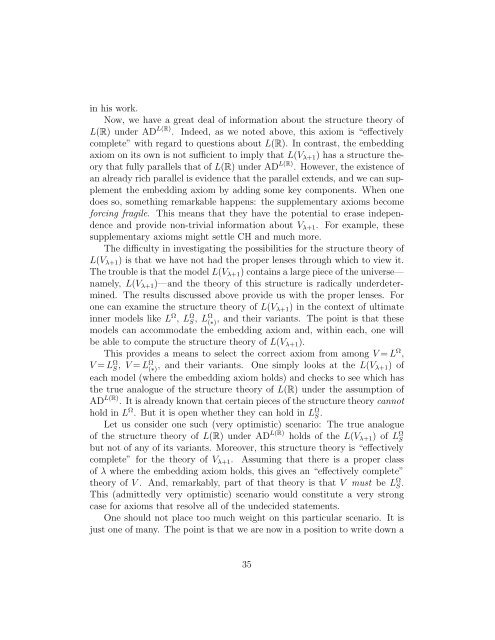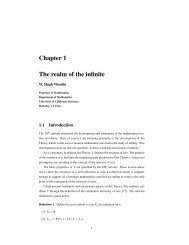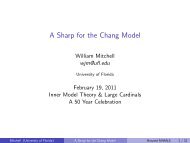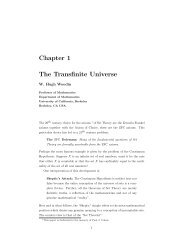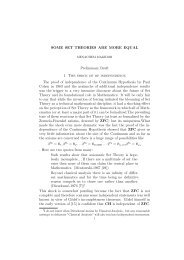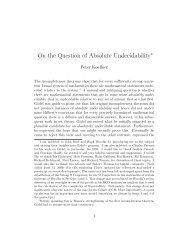The Continuum Hypothesis - Logic at Harvard
The Continuum Hypothesis - Logic at Harvard
The Continuum Hypothesis - Logic at Harvard
Create successful ePaper yourself
Turn your PDF publications into a flip-book with our unique Google optimized e-Paper software.
in his work.Now, we have a gre<strong>at</strong> deal of inform<strong>at</strong>ion about the structure theory ofL(R) under AD L(R) . Indeed, as we noted above, this axiom is “effectivelycomplete” with regard to questions about L(R). In contrast, the embeddingaxiom on its own is not sufficient to imply th<strong>at</strong> L(V λ+1 ) has a structure theoryth<strong>at</strong> fully parallels th<strong>at</strong> of L(R) under AD L(R) . However, the existence ofan already rich parallel is evidence th<strong>at</strong> the parallel extends, and we can supplementthe embedding axiom by adding some key components. When onedoes so, something remarkable happens: the supplementary axioms becomeforcing fragile. This means th<strong>at</strong> they have the potential to erase independenceand provide non-trivial inform<strong>at</strong>ion about V λ+1 . For example, thesesupplementary axioms might settle CH and much more.<strong>The</strong> difficulty in investig<strong>at</strong>ing the possibilities for the structure theory ofL(V λ+1 ) is th<strong>at</strong> we have not had the proper lenses through which to view it.<strong>The</strong>troubleis th<strong>at</strong>themodel L(V λ+1 )contains alargepiece oftheuniverse—namely, L(V λ+1 )—and the theory of this structure is radically underdetermined.<strong>The</strong> results discussed above provide us with the proper lenses. Forone can examine the structure theory of L(V λ+1 ) in the context of ultim<strong>at</strong>einner models like L Ω , L Ω S , LΩ (∗), and their variants. <strong>The</strong> point is th<strong>at</strong> thesemodels can accommod<strong>at</strong>e the embedding axiom and, within each, one willbe able to compute the structure theory of L(V λ+1 ).This provides a means to select the correct axiom from among V=L Ω ,V=L Ω S , V=LΩ (∗) , and their variants. One simply looks <strong>at</strong> the L(V λ+1) ofeach model (where the embedding axiom holds) and checks to see which hasthe true analogue of the structure theory of L(R) under the assumption ofAD L(R) . Itisalreadyknownth<strong>at</strong>certainpieces ofthestructuretheorycannothold in L Ω . But it is open whether they can hold in L Ω S .Let us consider one such (very optimistic) scenario: <strong>The</strong> true analogueof the structure theory of L(R) under AD L(R) holds of the L(V λ+1 ) of L Ω Sbut not of any of its variants. Moreover, this structure theory is “effectivelycomplete” for the theory of V λ+1 . Assuming th<strong>at</strong> there is a proper classof λ where the embedding axiom holds, this gives an “effectively complete”theory of V. And, remarkably, part of th<strong>at</strong> theory is th<strong>at</strong> V must be L Ω S .This (admittedly very optimistic) scenario would constitute a very strongcase for axioms th<strong>at</strong> resolve all of the undecided st<strong>at</strong>ements.One should not place too much weight on this particular scenario. It isjust one of many. <strong>The</strong> point is th<strong>at</strong> we are now in a position to write down a35


